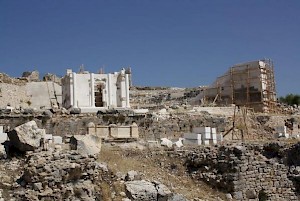Opramoas of Rhodiapolis
Opramoas of Rhodiapolis: Lycian benefactor from the age of the Roman emperor Antoninus Pius.

The main source documenting Opramoas' life and activities is the epitaph of his monumental tomb in Rhodiapolis, which is the longest inscription in Anatolia. It includes twelve letters to Roman emperors, nineteen letters to Roman provincial officials, thirty-three documents related to the Lycian League. Other inscriptions have been found on monuments he had rebuilt all over Lycia, in towns like Limyra, Myra, Tlos, and Xanthus.
Opramoas was a contemporary of the Roman emperor Antoninus Pius (r.138-161). His father was from Rhodiapolis, while his mother was from Korydalla. Among his relatives were wealthy Lycians like Gaius Julius Demosthenes of Oenoanda and Licinius Longus, the "lyciarch" (president of the Lycian League).

Opramoas' ancestors had attained high positions like the lyciarchia, the strategia, and the hipparchia. Originally, the two last-named offices were army commands, but under the more peaceful conditions of the Roman Empire, they were probably civil magistracies. Opramoas' brother Apollonius served as chief priest of the imperial cult, as scribe of the Lycian League, and as lyciarch. The documents in Opramoas' long inscription suggest (but do not prove) that he acted as lyciarch as well.
Almost all Lycian cities received some form of help from Opramoas, especially after an earthquake had destroyed many civil buildings in 141 CE. He contributed lavishly: the highest support went to Myra (100,000 denarii) and Tlos (80,000 denarii). Apart from these contributions to urban life, he also supported individual people, providing food for the poor and dowries for young girls.
The surroundings of Opramoas' tomb were cleaned in 2006. It is currently being reconstructed.